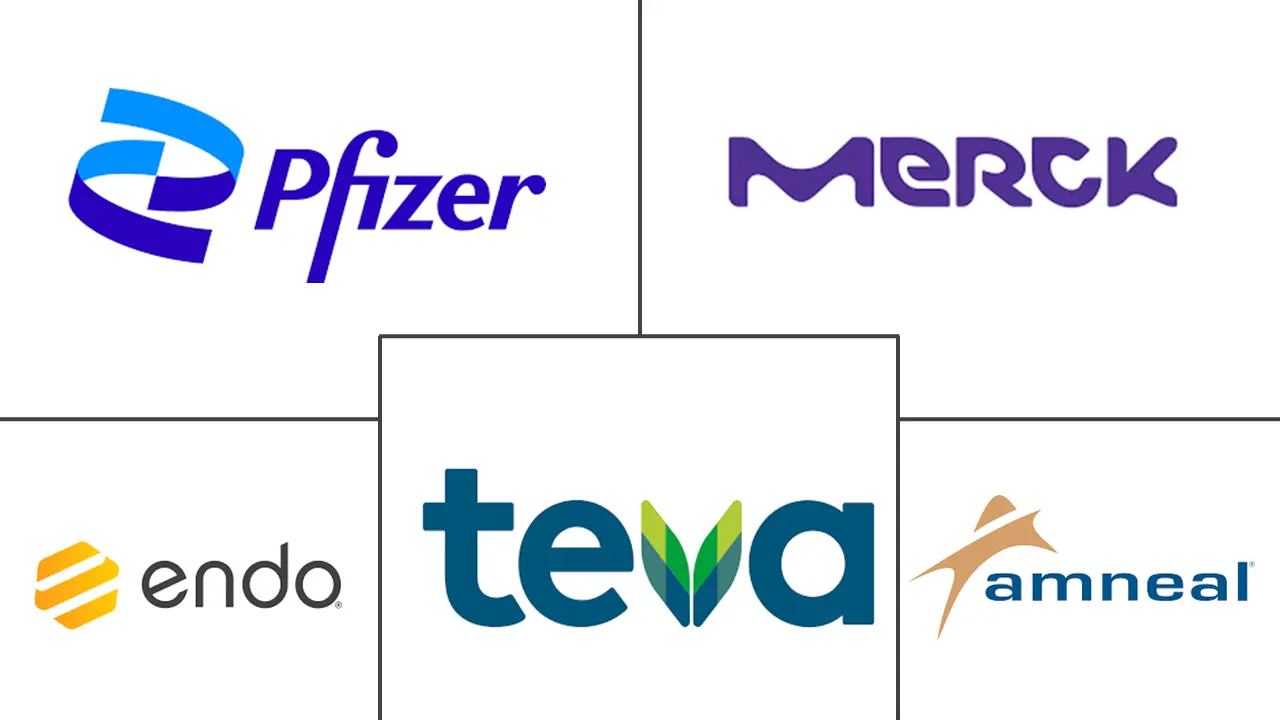Lidocaine Hydrochloride Market Size and Share
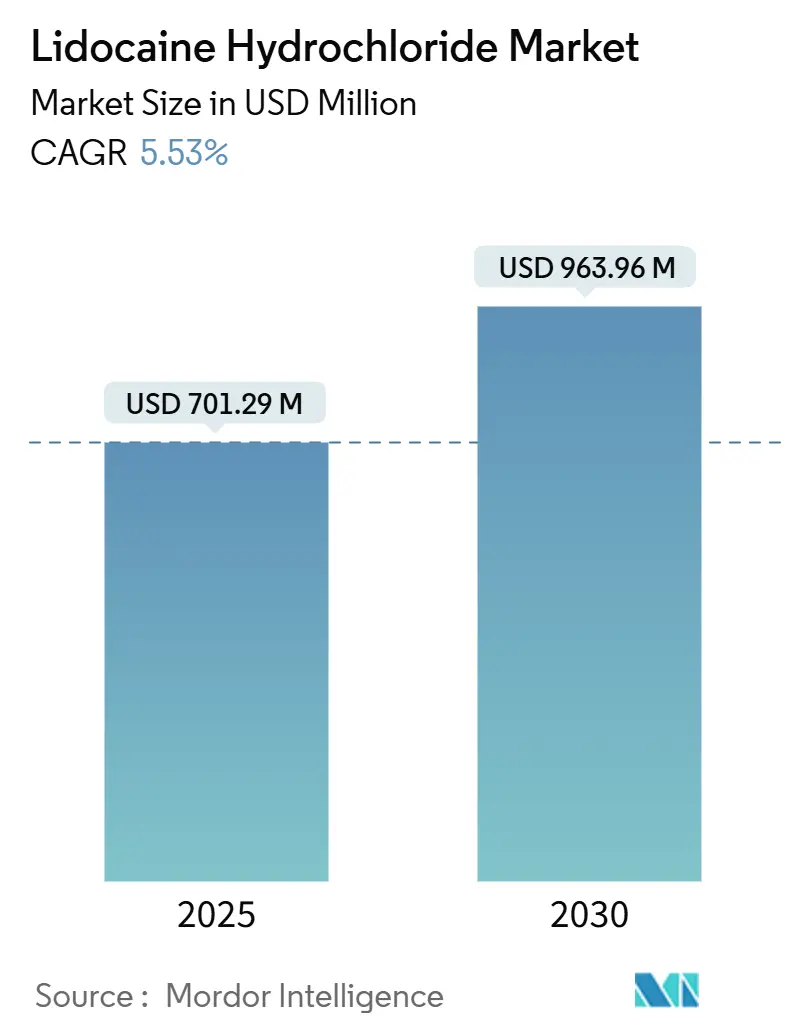
Lidocaine Hydrochloride Market Analysis by Mordor Intelligence
The Lidocaine Hydrochloride Market size is estimated at USD 701.29 million in 2025, and is expected to reach USD 963.96 million by 2030, at a CAGR of 5.53% during the forecast period (2025-2030).
Consistent demand for a dependable local anesthetic across surgical, dental, and pain-management settings underpins this steady expansion. Growth is reinforced by the shift toward minimally invasive procedures, rising elective surgery volumes, and an expanding base of neuropathic-pain patients who benefit from topical formulations. Competitive intensity is moderate; incumbents rely on broad distribution networks while new entrants exploit supply disruptions. Regulatory approvals of novel delivery systems such as low-dose high-bioavailability transdermal patchesare broadening therapeutic options and stimulating product innovation across the lidocaine hydrochloride market.
Key Report Takeaways
- By dosage form, injectables held 42.62% of the lidocaine hydrochloride market share in 2024, whereas patches are projected to post the quickest 7.44% CAGR to 2030.
- By application, dental procedures accounted for 36.54% of the lidocaine hydrochloride market size in 2024, while post-herpetic neuralgia treatment is set to expand at a 9.62% CAGR.
- By end user, hospitals led with 58.91% of the lidocaine hydrochloride market share in 2024; specialty clinics represent the fastest-growing channel at 10.83% CAGR.
- By geography, North America contributed 37.43% revenue in 2024, whereas Asia-Pacific is forecast to grow at an 8.47% CAGR through 2030.
Global Lidocaine Hydrochloride Market Trends and Insights
Drivers Impact Analysis
| Driver | (~) % Impact on CAGR Forecast | Geographic Relevance | Impact Timeline |
|---|---|---|---|
| Rising Volume of Minimally-Invasive & Elective Surgeries | +1.2% | Global, with concentration in North America & Europe | Medium term (2-4 years) |
| Increasing Prevalence of Ventricular Arrhythmias | +0.8% | Global, aging populations in developed markets | Long term (≥ 4 years) |
| Growing Adoption of Topical Lidocaine Patches for Neuropathic Pain | +1.5% | North America & Europe, expanding to Asia-Pacific | Short term (≤ 2 years) |
| Rapid Expansion of Dental Procedures in Emerging Economies | +1.1% | Asia-Pacific, Latin America, Middle East & Africa | Medium term (2-4 years) |
| FDA Approvals of Low-Dose High-Bioavailability Transdermal Systems | +0.7% | North America, with regulatory spillover to EU | Short term (≤ 2 years) |
| 3D-Printed Personalized Lidocaine Delivery Devices | +0.3% | North America & Europe, early-stage adoption | Long term (≥ 4 years) |
| Source: Mordor Intelligence | |||
Rising Volume of Minimally Invasive & Elective Surgeries
Outpatient laparoscopic and endoscopic procedures increasingly rely on lidocaine for swift onset anesthesia that supports same-day discharge. Evidence shows that intravenous lidocaine reduces postoperative pain scores by 40% and lowers opioid consumption in abdominal surgery patients.[1]Tian-Long Ji, “Intravenous Lidocaine Significantly Reduces Postoperative Pain,” Journal of Clinical Medicine, mdpi.comHospitals incorporate the drug into enhanced-recovery pathways to manage costs tied to extended admissions. As ambulatory surgical centers compete on throughput, demand for predictable analgesia augments the lidocaine hydrochloride market. Suppliers able to guarantee continuous injectable supply capture share in regions where elective surgery volumes rebound most rapidly following pandemic-related slowdowns.
Increasing Prevalence of Ventricular Arrhythmias
Cardiovascular disease burdens an aging demographic, elevating the clinical use of lidocaine as a class IB anti-arrhythmic. Emergency departments value its rapid onset and brief half-life for controlled rhythm stabilization, particularly during percutaneous coronary interventions. Updated protocols recommend lidocaine to mitigate arrhythmia-related complications in cardiac catheterization labs.[2]Vault Pfizer Medical Affairs, “Lidocaine Injection in Cardiac Arrhythmia Management,” Pfizer, pfizer.com Broader availability of advanced cardiac care in emerging economies further enlarges the drug’s addressable patient pool.
Growing Adoption of Topical Lidocaine Patches for Neuropathic Pain
Opioid-sparing treatment strategies accelerate uptake of 1.8% and 5% lidocaine patches among chronic-pain patients. The FDA cleared the first generic 1.8% transdermal system in March 2025, spurring price competition that widens access.[3]U.S. Food and Drug Administration, “Warning Letter to TKTX Company,” fda.gov Clinical data confirm significant pain-score reductions when patches are combined with spinal cord stimulation for elderly post-herpetic neuralgia cases. These factors drive sustained double-digit unit growth for the segment, particularly in North America and Western Europe.
Rapid Expansion of Dental Procedures in Emerging Economies
Rising disposable income enables greater uptake of preventive and cosmetic dentistry in Asia-Pacific and Latin America. Lidocaine aerosols, creams, and computer-controlled injection systems improve chairside experience and encourage repeat visits. A 5.6% lidocaine aerosol cut periodontal-procedure pain scores in a 167-patient trial without adverse events. Nanocapsule-based gels that extend mucosal analgesia further differentiate premium offerings, helping manufacturers protect margins in price-sensitive markets.
Restraints Impact Analysis
| Restraint | (~) % Impact on CAGR Forecast | Geographic Relevance | Impact Timeline |
|---|---|---|---|
| Adverse CNS and cardiovascular toxicity risks | -0.9% | Global, heightened regulatory scrutiny in developed markets | Short term (≤ 2 years) |
| Generic price erosion and reimbursement pressures | -1.3% | North America and Europe, spreading to emerging markets | Medium term (2-4 years) |
| Volatility in xylidine raw-material supply | -0.8% | Global, concentrated impact in Asia-Pacific manufacturing hubs | Short term (≤ 2 years) |
| Stricter solvent-emission regulations in API manufacturing | -0.5% | North America and Europe, expanding to Asia-Pacific | Long term (≥ 4 years) |
| Source: Mordor Intelligence | |||
Adverse CNS & Cardiovascular Toxicity Risks
The therapeutic window for lidocaine remains narrow, prompting regulators to monitor high-strength topical products marketed for cosmetic procedures. In March 2024 the FDA warned a manufacturer marketing unapproved 40% lidocaine creams, underscoring safety vigilance. Clinicians must screen for hepatic impairment and methemoglobinemia risk, which can limit dosing flexibility. These concerns moderate uptake in elective aesthetic settings where alternatives with wider margins of safety are gaining traction.
Generic Price Erosion & Reimbursement Pressures
Patent expiry across multiple formulations invites rapid commoditization. Payers increasingly mandate step therapy favoring low-cost generics, compressing branded-product margins. The first generic 1.8% patch received approval in March 2025 and triggered immediate formulary switches at US pharmacy benefit managers. Similar dynamics are expected in Europe once exclusivity lapses, curbing revenue growth for originator companies.
Segment Analysis
By Dosage Form: Patches Lead Innovation Wave
The injectables sub-segment represented 42.62% of the lidocaine hydrochloride market size in 2024 owing to its indispensability in surgical and emergency settings. Supply shortages from incumbent producers such as Pfizer and Fresenius Kabi prolonged lead times, yet facilitated share gains for agile suppliers introducing ready-to-use vials early in 2024. A second growth engine stems from patches, which post a 7.44% CAGR through 2030 as physicians and patients gravitate to non-invasive regimens. The March 2025 generic approval slashed unit costs by 35% within three months in the United States, broadening payer coverage and accelerating uptake. Creams, gels, and the emerging class of thermoresponsive nanogels sustain demand in dermatology and oral-wound applications where extended release is advantageous. Nanotechnology-enhanced formats employing polymeric nanocapsules improve mucosal permeation and represent a future competitive differentiator for manufacturers seeking margin defense.
Hospital pharmacies still prioritize multidose ampoules for versatility, but ambulatory surgical centers increasingly order pre-filled syringes to minimize preparation time and medication errors. The lidocaine hydrochloride market maintains a strong pipeline of 3D-printed dissolvable microneedle arrays tailored for post-operative incision care. This personalized-delivery trend widens the innovation moat for technology-driven brands and mitigates pure price competition in the injectables space. At the same time, patches address adherence challenges in chronic neuropathic pain, presenting the most compelling opportunity for volume expansion across the lidocaine hydrochloride industry.
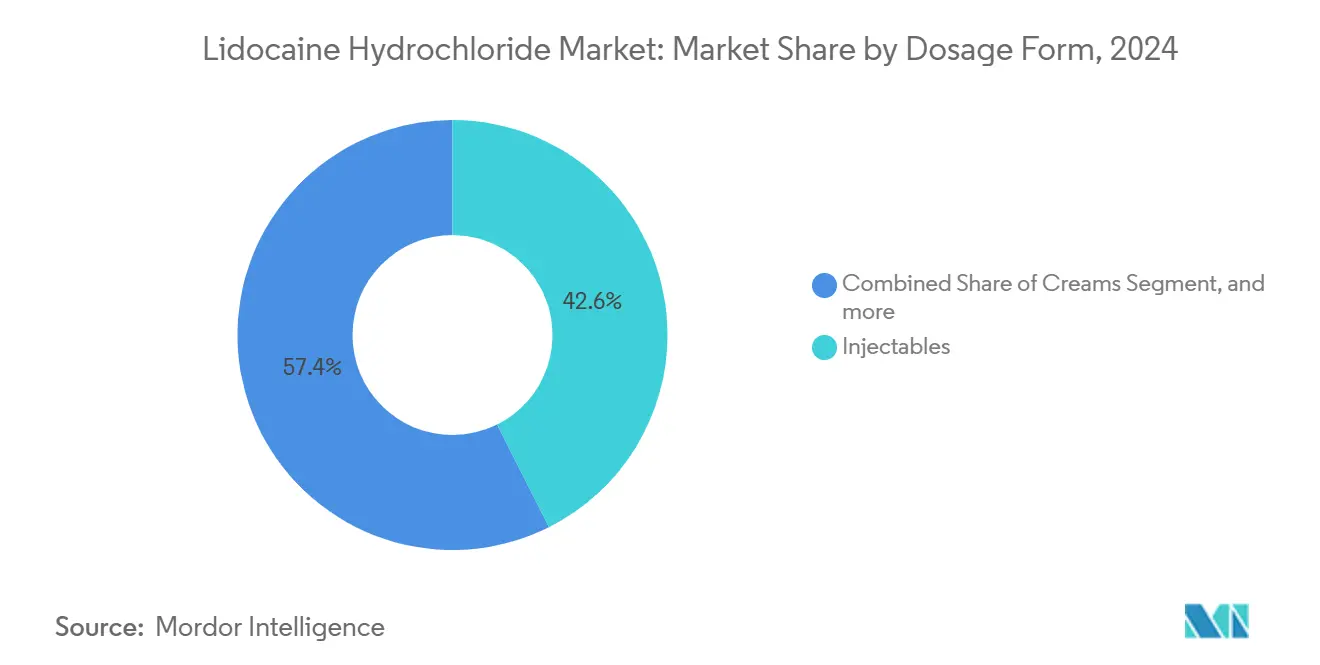
Note: Segment shares of all individual segments available upon report purchase
By Application: Post-Herpetic Neuralgia Drives Growth
Dental care captured 36.54% of 2024 revenue thanks to high procedure volumes in both developed and emerging markets. Clinics favor computer-controlled injection systems that cut onset time by 15 seconds on average, thus increasing chairside throughput. Post-herpetic neuralgia is forecast to generate the highest 9.62% CAGR, reflecting aging populations and updated pain-management guidelines promoting topical lidocaine ahead of systemic therapies. Combination regimens pairing 5% patches with spinal cord stimulation lowered mean pain scores from 2.7 to 1.6 in a 90-day study of elderly patients.
Cardiology preserves a steady niche where lidocaine’s dual anti-arrhythmic and anesthetic properties streamline intra-procedural care. Dermatology faces tighter oversight after multiple warnings on high-strength compounded creams, yet growth persists for aerosol formats that minimize cross-contamination. The lidocaine hydrochloride market size for oncology-adjunct wound care remains small but exhibits robust clinical-trial activity as nanocarrier formulations advance through Phase II studies.
By End User: Specialty Clinics Capture Growth
Hospitals controlled 58.91% of 2024 volume, anchored by high surgical throughput and continuous emergency-department demand. However, specialty clinics are projected to advance at a 10.83% CAGR to 2030 as payers favor outpatient care pathways. Chronic pain practices embrace long-acting patches that reduce opioid reliance, while dermatology and dental clinics invest in computer-guided injectors to enhance patient comfort.
Supply-chain fragility highlighted by 2024 shortages prompted the American Academy of Dermatology Association to establish a Drug Shortage Workgroup aimed at securing alternate distributors. Clinics increasingly sign direct-ship agreements with nimble manufacturers to protect inventory levels, a move that redistributes bargaining power within the lidocaine hydrochloride industry and fosters tighter integration between manufacturers and point-of-care providers.
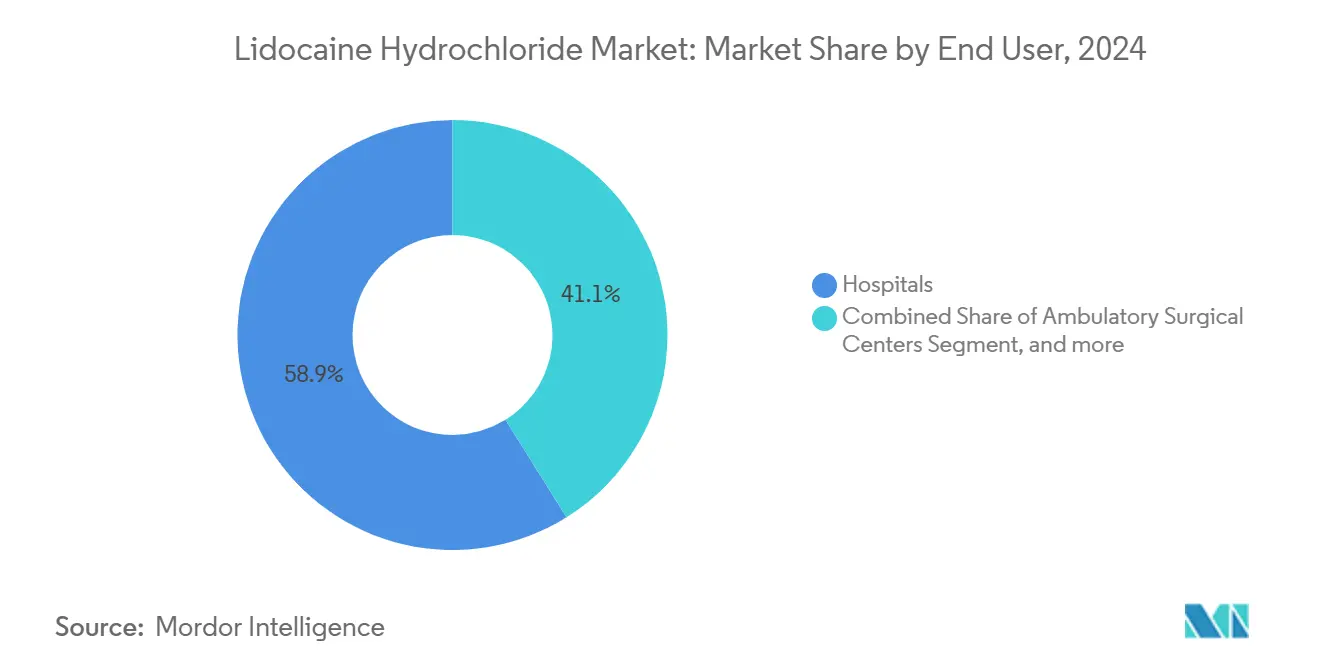
Note: Segment shares of all individual segments available upon report purchase
Geography Analysis
North America retained a 37.43% revenue share in 2024, underpinned by mature reimbursement systems and high elective-surgery volumes. The region also became the launchpad for the first generic 1.8% patch, which broadened access for Medicare and commercial-plan beneficiaries. United States drug-shortage data reveal recurring deficits in lidocaine vials, prompting hospital groups to diversify suppliers and renegotiate long-term contracts.
Europe follows with consistent demand driven by aging populations and harmonized regulatory pathways that expedite new-format approvals. German ambulatory centers reported a 12% rise in outpatient arthroscopic procedures in 2024, directly lifting lidocaine consumption. The lidocaine hydrochloride market size attributed to France and Italy shows resilient mid-single-digit growth as pain-management guidelines endorse topical routes before opioids.
Asia-Pacific delivers the highest 8.47% CAGR, reflecting broader insurance coverage and investment in domestic API capacity. India’s Bulk Drug Parks scheme incentivizes local production of key intermediates to curb dependency on imports. China’s biopharmaceutical sector benefits from provincial subsidies that lower facility-setup costs, enabling quick scale-up of lidocaine API manufacturing and reinforcing supply security for regional formulators.
Latin America experiences moderate expansion as Brazil and Mexico upgrade surgical infrastructure and dental-tourism inflows increase. Regulatory agencies are adopting fast-track reviews for critical anesthetics to avert shortages, a policy that favors established dossier holders. Middle East and Africa remain nascent but record double-digit volume gains where private hospital chains open day-surgery centers in urban hubs. Increasing public-sector procurement budgets for essential anesthetics establish a baseline demand that suppliers leverage for further penetration of premium topical formats.
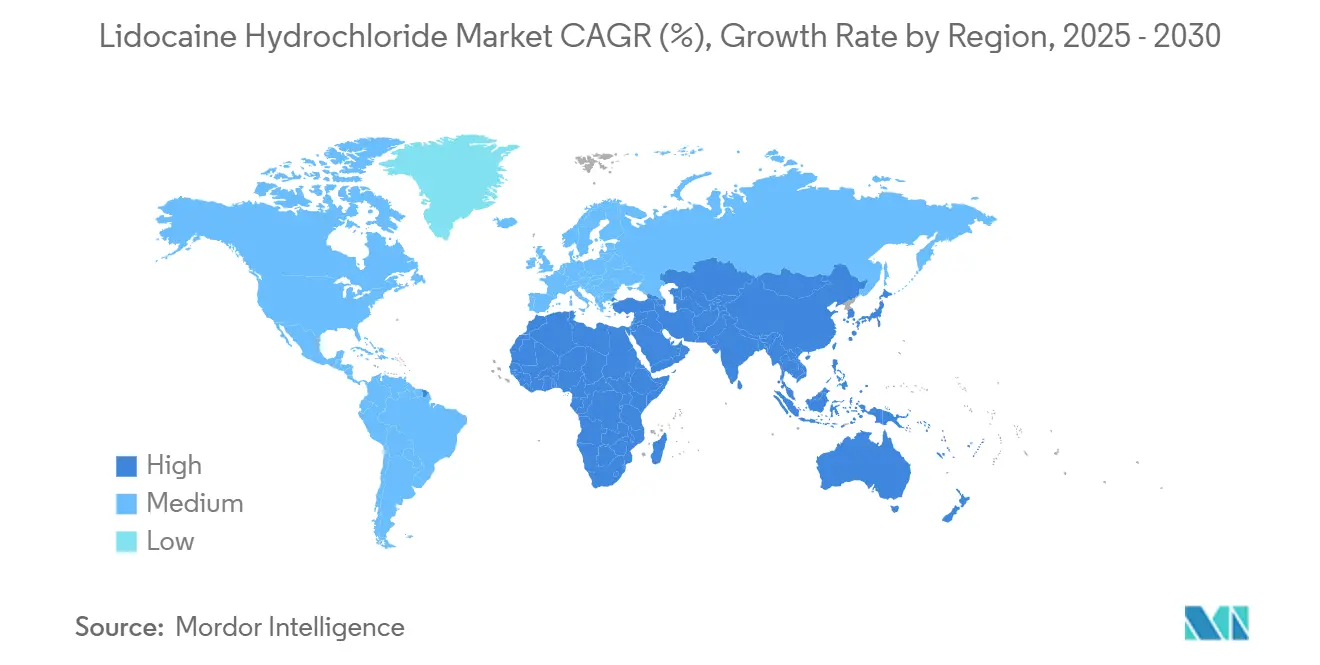
Competitive Landscape
The lidocaine hydrochloride market is moderately competitive and consists of several major players. Pfizer, Teva, Fresenius Kabi, and Hikma collectively account for major share of global injectable volumes, but intermittent production interruptions dilute their dominance. Sintetica US capitalized on the February 2024 shortage, supplying alternative vial sizes and capturing premium pricing for on-time deliveries. Aveva’s 2025 generic patch approval intensifies price competition in transdermal formats, compelling originators to accelerate next-generation product launches.
Strategic focus is shifting to differentiated delivery platforms. Multiple firms pilot microneedle arrays that localize lidocaine to the dermis and shorten onset to under one minute. The University of Nottingham showcased multi-material inkjet 3D printing for personalized tablets embedding lidocaine with anti-arrhythmic co-therapies, foreshadowing bespoke dosage regimens. Nanotechnology partnerships with academic labs are common as companies pursue prolonged release profiles without excipients that trigger allergic reactions.
Supply security emerged as a pivotal competitive lever after several FDA-listed manufacturers projected resupply of key injectable SKUs only in January 2026. Players with vertically integrated API capacity or diversified geographic sourcing mitigate this risk and secure multiyear purchase commitments from hospital group purchasing organizations. Marketing strategies emphasize clinical-economic evidence that reduced opioid use and shorter recovery times can offset premium pricing on advanced lidocaine systems. Intellectual-property filings reveal a tilt toward combination products blending lidocaine with anti-inflammatory or antioxidant agents that can extend label life and diversify revenue streams beyond traditional anesthetic indications.
Lidocaine Hydrochloride Industry Leaders
-
Pfizer Inc.
-
Merck KGaA
-
Teva Pharmaceutical Industries Ltd.
-
Amneal Pharmaceuticals Inc.
-
Endo International plc
- *Disclaimer: Major Players sorted in no particular order
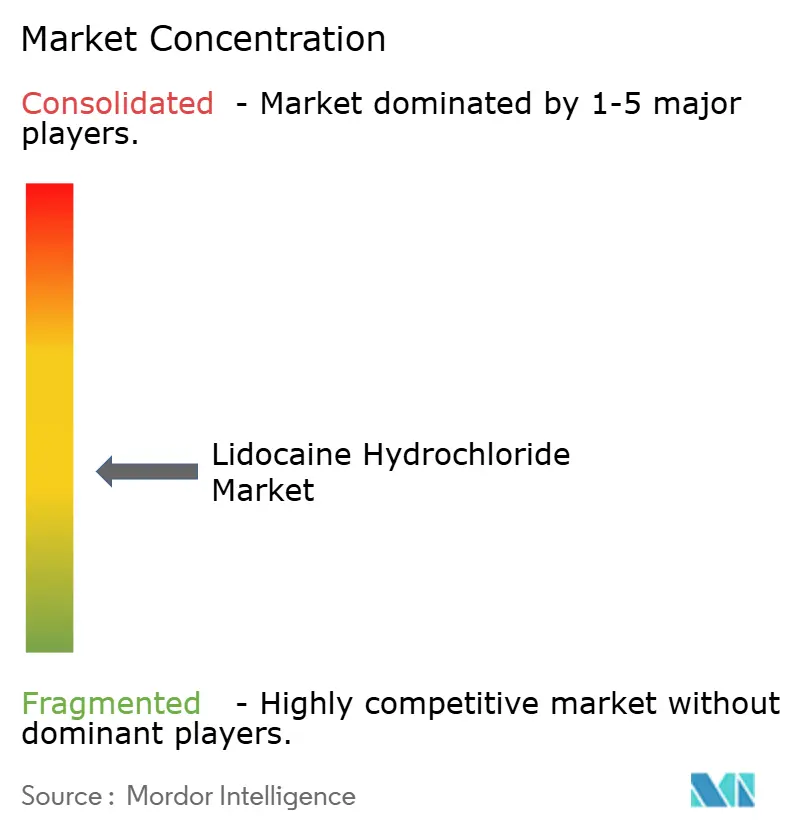


Recent Industry Developments
- March 2025: FDA approved the first generic lidocaine 1.8% patch by Aveva Drug Delivery Systems, creating significant price competition in the transdermal anesthetic market while maintaining bioequivalence to existing branded alternatives. This approval represents a milestone in expanding patient access to cost-effective pain management solutions for post-herpetic neuralgia and other neuropathic pain conditions.
- February 2025: AIP published research on nanotechnology-based drug delivery systems for lidocaine using Methyl-PEG2000-DSPE-PVP-LDC nanomaterials, demonstrating enhanced stability and reduced toxicity with potential applications in pain management, oncology, and chronic wound healing.
- January 2025: FDA approved Journavx (suzetrigine), a first-in-class non-opioid pain signal inhibitor priced at USD 15.50 per 50mg pill, creating competitive pressure on traditional lidocaine applications for moderate-to-severe acute pain management.
- October 2024: Imbed Biosciences has received U.S. Food and Drug Administration (FDA) 510(k) clearance to market Microlyte Ag/Lidocaine, the first antimicrobial wound dressing to integrate lidocaine for managing painful skin wounds. This advanced dressing employs Imbed’s patented synthetic matrix to deliver ionic and metallic silver alongside lidocaine, ensuring both antimicrobial protection and local anesthetic effects.
Research Methodology Framework and Report Scope
Market Definitions and Key Coverage
Our study defines the global lidocaine hydrochloride market as the aggregate annual revenue derived from finished pharmaceutical formulations, injectables, creams, gels, patches, and aerosol solutions, whose primary active ingredient is lidocaine HCl and that are approved for human therapeutic or diagnostic use. The scope spans Rx and over-the-counter channels across 17 countries, with 2025 taken as the baseline.
Scope exclusion: Combination products where lidocaine HCl is not the principal active and industrial-grade API traded for chemical synthesis are outside the frame.
Segmentation Overview
- By Dosage Form
- Creams
- Patches
- Injectables
- Gels
- Aerosol Solutions
- Other Dosage Forms
- By Application
- Heart Arrhythmia
- Dental Procedures
- Epilepsy Management
- Post-Herpetic Neuralgia
- Cosmetic Dermatology
- Other Applications
- By End User
- Hospitals
- Ambulatory Surgical Centers
- Specialty Clinics
- By Geography
- North America
- United States
- Canada
- Mexico
- Europe
- Germany
- United Kingdom
- France
- Italy
- Spain
- Rest of Europe
- Asia-Pacific
- China
- Japan
- India
- Australia
- South Korea
- Rest of Asia-Pacific
- Middle East & Africa
- GCC
- South Africa
- Rest of Middle East & Africa
- South America
- Brazil
- Argentina
- Rest of South America
- North America
Detailed Research Methodology and Data Validation
Primary Research
Several semi-structured interviews and short surveys with hospital pharmacists, anesthesia specialists, and regional wholesalers in North America, Europe, and Asia-Pacific provided us with real-world average selling prices, typical vial and patch usage per procedure, and expected formulary shifts. These conversations allowed Mordor analysts to validate desk estimates and refine model assumptions before sign-off.
Desk Research
We began by mapping approved strengths, dosage forms, and labeling changes from open sources such as the US FDA Orange Book, the European Medicines Agency product database, and the WHO Model List of Essential Medicines, which anchor volume potential. Regulatory safety alerts, CDC surgical procedure statistics, and UN Comtrade HS-code flows then helped us size regional demand pools. Our analysts complemented these with company 10-Ks, investor decks, and clinical-trial registries that signal pipeline launches and price dynamics.
Subscription repositories, including D&B Hoovers for manufacturer revenues and Dow Jones Factiva for event monitoring, allowed us to benchmark revenue splits and screen for one-off shocks, such as recalls and plant outages. The sources cited illustrate, not exhaust, the evidence base we tapped for triangulating numbers.
Market-Sizing & Forecasting
A top-down construct starts with procedure incidence and prevalence metrics, such as dental extractions, arrhythmia ablation counts, and dermatologic surgeries, which are then multiplied by lidocaine dose norms and ASPs to rebuild country revenue. Select bottom-up checks, including supplier roll-ups and sampled hospital purchase orders, confirm totals and highlight gaps. Key variables tracked include elective surgery backlog clearance, generic penetration rates, raw-material cost inflation, prescription-to-OTC channel mix, and regional reimbursement shifts. Multivariate regression, informed by our primary panels, projects each driver through 2030; sensitivity bands cover regulatory or supply-chain shocks.
Data Validation & Update Cycle
Model outputs pass a two-stage analyst review where outliers are compared against historical variance bands and peer databases. When deviations exceed set thresholds, we re-contact experts. Reports refresh annually, and material events trigger interim tweaks so clients receive an always-current baseline.
Why Mordor's Lidocaine Hydrochloride Baseline Commands Reliability
Estimates from different publishers often diverge because each chooses unique ingredient definitions, dosage baskets, and refresh cadences, and few disclose those choices clearly.
Key gap drivers include: some studies merge lidocaine base or veterinary grades with lidocaine HCl; others extrapolate one-region sales globally; still others embed API trade twice when adding finished-dose revenues. Mordor Intelligence delineates ingredient purity, channels, and therapeutic end use upfront, applies mixed top-down and bottom-up validation once, and updates every year, minimizing structural bias.
Benchmark comparison
| Market Size | Anonymized source | Primary gap driver |
|---|---|---|
| USD 701 M (2025) | Mordor Intelligence | - |
| USD 1.02 B (2024) | Global Consultancy A | Includes lidocaine base and OTC blends; growth curve extrapolated from limited audits |
| USD 752 M (2023) | Industry Association B | Captures only prescription injectables, excludes topical forms; single-region uplift to global |
| USD 2.57 B (2023) | Trade Journal C | Adds high-purity API trade value to finished doses; no double-count adjustment |
Taken together, the comparison shows that when scope creep and unvetted assumptions are isolated, our disciplined, clearly documented approach yields a transparent, decision-ready baseline clients can trust.


Key Questions Answered in the Report
How large is the lidocaine hydrochloride market in 2025?
The market is valued at USD 701.29 million in 2025 and is projected to reach USD 963.96 million by 2030 at a 5.53% CAGR.
Which region grows fastest through 2030?
Asia-Pacific records the highest 8.47% CAGR due to wider healthcare access, domestic API incentives, and rising elective-procedure volumes.
What dosage form is expanding most rapidly?
Patches post the fastest 7.44% CAGR as generic launches lower costs and clinical guidelines favor opioid-sparing topical analgesia.
Why are specialty clinics gaining share?
Payers shift procedures to outpatient settings; specialty clinics adopt advanced lidocaine delivery systems that improve patient comfort and throughput, driving a 10.83% CAGR.
What are the main restraints on market growth?
Safety concerns over CNS and cardiovascular toxicity, generic-driven price erosion, and raw-material supply volatility.
Page last updated on:
